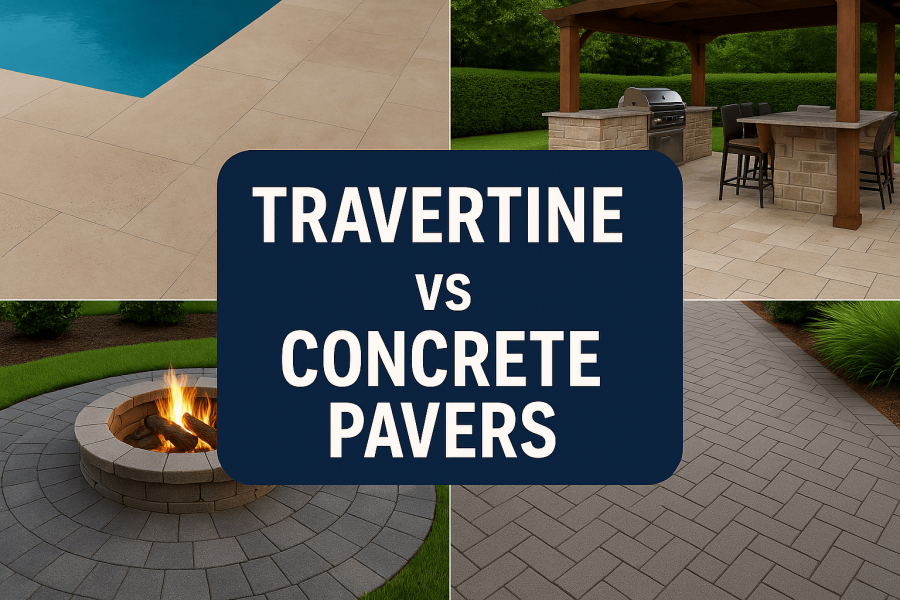- >
Why you Should Build a Rain Garden in your Florida Yard
- By: Cheli Scott
- Date: Dec 28 2022
Similar Articles
Artificial Turf vs Sod for Lawns, Backyards & DIY Makeovers
Thinking about artificial turf or sod? Discover the pros and cons of each—from cost and maintenance to durability and pet-friendliness—so you can choose the best option for your lawn or backyard project.
Travertine vs Concrete Pavers for Florida Pool Decks, Patios, Fire Pits & More | bhild
Compare travertine and concrete pavers for Florida pool decks, patios, and driveways — from heat retention and slip resistance to cost, maintenance, and curb appeal.
Beat the Heat: Florida Summer Landscape Survival Guide
Beat the Florida heat with smart summer landscaping. From drought‑tolerant plants to shaded retreats, this guide covers designs, materials, and maintenance tips to keep your yard thriving all season long.
Why you should build a rain garden in your Florida yard
If you have a swampy spot in your yard, you might want to build a rain garden as a beautiful way to manage storm water runoff.
Florida receives over 50 inches of rain water a year, dumping a lot of water onto your lawn. Rain gardens give runoff a place to gather as it absorbs back into the ground, making them an ideal solution to insect and drainage problems.
Storm water runoff
As water reabsorbs into the earth, it carries with it particulates, chemicals, and other nasty stuff that returns to waterways. Fortunately, as it moves through the soil it is naturally filtered making it safe to be used again.
Water evaporated off of puddles and hard surfaces like parking lots is lost. Rain gardens are a way to help collect the water to return it to natural aquifers. Your beautiful rain garden is an important part of the water cycle and preventing water pollution.
What is a rain garden?
A rain garden is a garden populated by native plants suited to the correct conditions, built where it can collect rain water, and allow it to filter slowly back into the earth.
These gardens can be beautiful with a variety of native drought, tolerant plants that add a lot of visual interest to a yard. These gardens also solve the problem of ugly, soggy ditches and valleys in your yard developing mud and mosquitos.
The benefits of rain gardens
Filling water collecting areas with plants reduces erosion in your yard and increase the usability and enjoyability of your outdoor space after heavy rains. They reduce water pollution by filtering water and are great for the environment.
These simple gardens require little maintenance and reduce mosquitos in your yard, while promoting beneficial insects and wildlife.
How to build a rain garden
Rain garden designs aren’t complicated, requiring only the space to build them, soil, compost, and plants. You can add additional decorations to make them more interesting like rocks and logs. Here’s how to get started:
Find a location
The first thing you should do when building a rain garden is find a suitable location. Find a low spot in your yard at least ten feet away from your house and twenty feet away from any septic system or well. You are looking for well draining soil that also is low lying area and a natural collection point for standing water. Depending on the plants you choose, you will want it to be in full sun or at most partial shade.
Before you put in a garden it is a good idea to have your soil tested. Clay soil will drain more slowly than soil mostly composed of sand. A slower draining soil type will require a wider rain garden to filter runoff.
Remove the existing turf
In order to remove the existing turf of the area you want to make your rain garden, you can lay down a plastic tarp over the area for a few weeks until the existing vegetation dies off. Then you can easily dig out the dirt and dead foliage with a sharp spade.
Be sure to call 811 before you dig.
Plan the garden size and shape
According to the University of Florida the higher the slope of your yard, the deeper the rain garden will need to be. A natural slope of less than 4% will require a 3-5 inch deep garden, while a 8% slope should have an 8 inch deep garden.
To determine the width and shape, use a garden hose to see where water flows in your yard. Common shapes are kidneys and ovals, but there is no prescribed shape. Choose what you think looks best and works for the area. There is no exact science to determining garden size, but experts say they should be between 100 and 300 square feet.
Prepare the soil
In order for water to drain evenly, you will want to create a level surface area for it to sink into. If there is a natural slope, create a small wall, called a berm, on the downhill side with excess soil so that water stays in the rain garden when it fills.
Till compost into the soil of the excavated area to give your plants a good start and add a two inch base layer of mulch before you add top soil and plants. These steps will help your soil hold moisture and provide nutrients for your new plants. When you add your plants, add another three inch layer of mulch to help retain moisture.
Install piping
If you want your rain garden to drain the excess water from your roof, you can run a pipe from your downspouts directly to your rain garden. This isn’t required for a rain garden to work, but is a nice idea for those who want to go an extra step.
Choosing rain garden plants
You can choose a variety of native plants for rain gardens. Choosing native plants with deep root systems discourages weeds and encourages your plants to thrive in the environment they were meant for. Place plants that can stand having “wet feet” after heavy rainfall in the center of the garden, while plants that can only tolerate occasional standing water should go at the edges. You can choose a blend of native grasses, flowers, and statement plants to make an interesting arrangement.
Native plants
There are a number of native species you can choose from to create a lush Florida landscape. Nearly 3,000 native plants grow in Florida, meaning there is bound to be something that appeals to you. Whatever you choose, you will want them to be drought friendly, but also tolerate occasional flooding, and require minimal fertilization. We’ve listed some of the most popular for rain gardens below:
Elephant ears
For some vertical interest, consider this beautiful plant. It grows quickly and tolerates moisture well. They grow in full sun to partial shade, producing lovely, wide green leaves. Elephant ears make a dramatic statement in a Florida garden and give it a tropical look.
Swamp Sunflower
These pretty yellow flowers are a fun addition to a rain garden. They tolerate moisture and grow quickly, reaching as high as four feet tall. Swamp sunflowers attract pollinators like hummingbirds and butterflies in addition to be being beautiful themselves.
Cinnamon Fern
For another lush, tropical looking plant, consider Cinnamon fern. The feathery, green leaves make pretty foliage and it tolerates heavy rain. While it grows slowly, it will get as large as five feet high, making it a dramatic addition to a rain garden.
Goldenrod
Goldenrod is a classic, attractive native plant that produces bright yellow flowers in clumps. It grows well in poor soil and will thrive in sunny conditions. This plant can get as big as five feet tall and three feet wide, making it another show stopper. Too much fertilization can actually make this plant weak and floppy, so a lean environment like a rain garden is an ideal home for it.
Wiregrass
If you are interested in including grasses in your rain garden, wiregrass is a fast growing, attractive grass that tolerates partial sun. It does well in sandy soils and doesn’t require extra fertilization to thrive. It tends to form clumps, making it an interesting specimen to incorporate into a landscaping design.
Don’t be afraid to ask for help
Rain gardens are pretty simple and maintenance free, but if you need help removing turf, laying mulch, or excavating land consider working with a professional like the ones at bhild.com. Call us today, or fill out our form here for a free estimate on lawn services!











